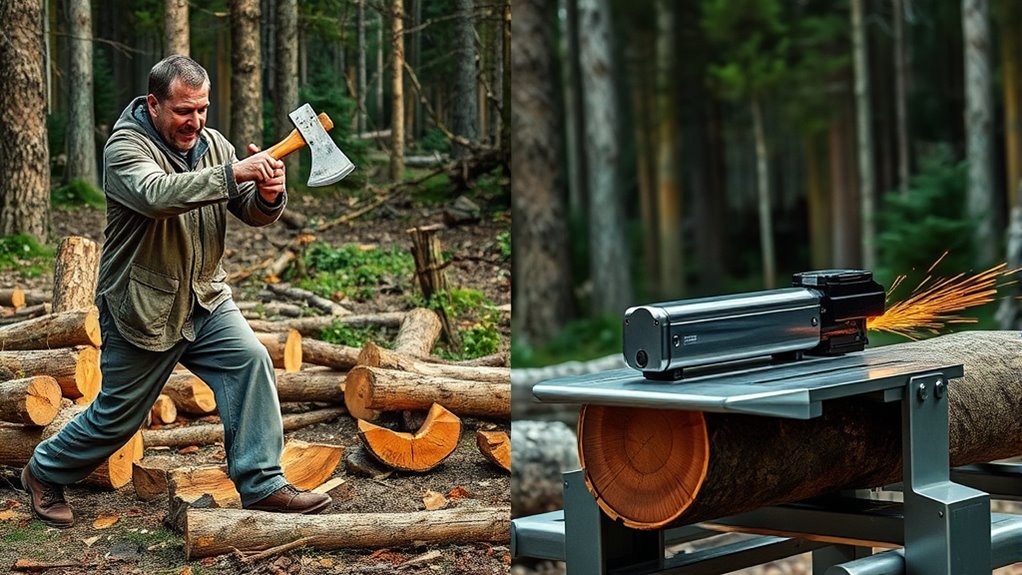Manual log splitting uses simple tools like axes or mauls, requiring physical effort, skill, and proper technique. Hydraulic splitters rely on hydraulic pressure, offering faster, more efficient results with less physical effort but higher costs and energy use. While manual methods are portable and eco-friendly, hydraulic machines handle larger loads quickly but are less portable. To decide which suits your needs best, consider safety, speed, cost, and environmental impact—you’ll find more details as you explore further.
Key Takeaways
- Manual log splitting relies on physical strength and simple hand tools, while hydraulic splitting uses powered cylinders for automatic force application.
- Hydraulic splitters are faster and suitable for large quantities, whereas manual methods are slower but more portable and cost-effective.
- Manual techniques require skill and endurance, with higher safety risks from fatigue, unlike hydraulic systems with built-in safety features.
- Hydraulic tools consume energy and have a larger environmental footprint, whereas manual splitting is eco-friendly with zero emissions.
- Choice depends on workload, budget, safety considerations, and environmental values, with hydraulic offering efficiency and manual offering simplicity.
The Basics of Manual Log Splitting
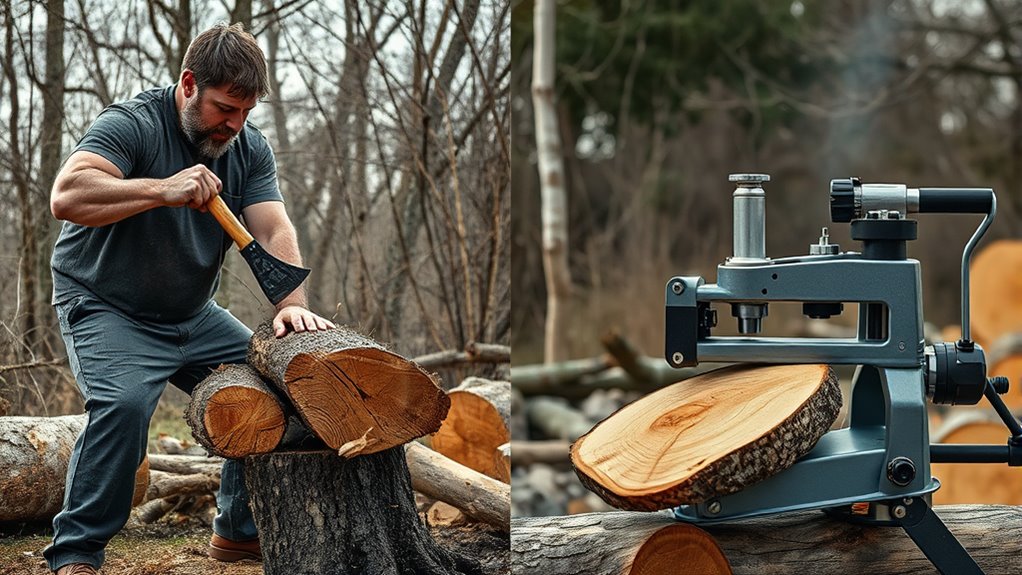
Manual log splitting involves using simple hand tools, like an axe or maul, to break down logs into smaller pieces. You position the log on a stable surface or hold it firmly between your legs, then swing the axe or maul with controlled force. Accurate aim is essential to split the wood along its grain effectively. You may need to strike multiple times or reposition the log to achieve the desired size. Proper technique reduces effort and minimizes safety risks. Using the right tool for the job, such as a heavy maul for tough logs, makes the process more efficient. While it requires physical effort and skill, manual splitting offers a straightforward, low-cost method to process firewood without the need for power tools.
The Mechanics of Hydraulic Log Splitting
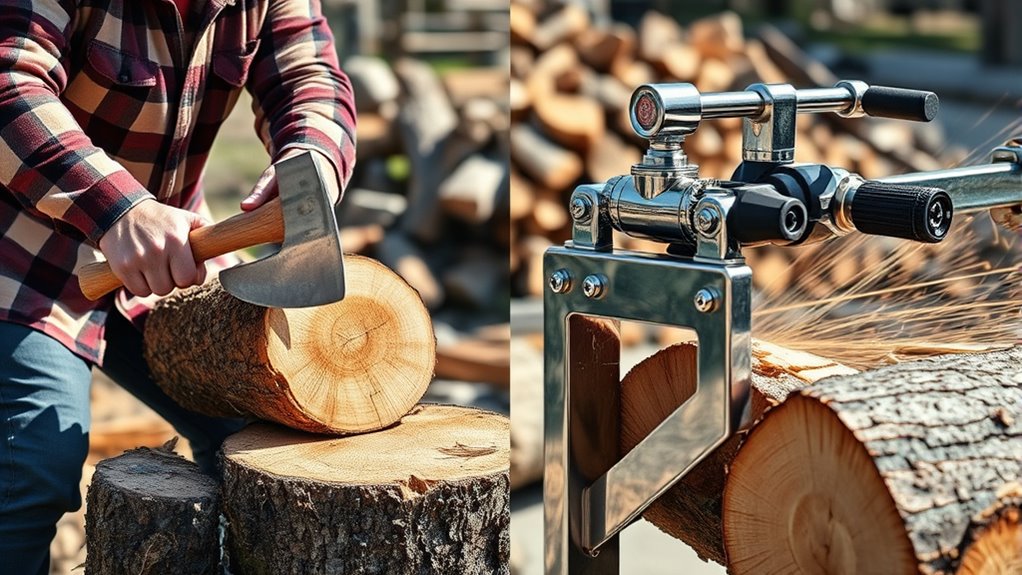
You’ll want to understand how the hydraulic cylinder uses pressure to generate powerful force, making splitting easier. The system’s pressure and force dynamics make certain the log is split efficiently without excessive effort. Safety mechanisms, like pressure relief valves, work to protect you during operation and prevent accidents.
Hydraulic Cylinder Operation
Hydraulic log splitting relies on a cylinder that converts hydraulic pressure into linear force, making the splitting process efficient and powerful. When you activate the hydraulic system, fluid is pumped into the cylinder through a valve. This increases pressure inside the cylinder, pushing the piston rod forward with great force. The piston is connected to a ram that directly applies pressure to the log. As the piston extends, it exerts a strong, steady force that splits the wood along its grain. When the log splits, the pressure is released, and the piston retracts. This cycle repeats as needed, allowing you to split multiple logs quickly and with minimal effort. The cylinder’s design guarantees consistent force delivery, making hydraulic log splitting a reliable and efficient method.
Pressure and Force Dynamics
Understanding the pressure and force dynamics in hydraulic log splitting is essential to grasp how the system efficiently splits wood. Hydraulic systems rely on applying force through pressurized fluid, which translates into powerful, consistent pressure on the log. The key factors include the pressure exerted by the hydraulic cylinder, the area of the piston, and the resulting force. As pressure increases, so does the force, allowing you to split tougher logs with less effort.
- Hydraulic pressure is measured in PSI, indicating the force applied.
- The piston area determines how much force is generated at a given pressure.
- Force equals pressure multiplied by piston area, driving the splitting action.
- Consistent pressure guarantees steady, reliable splitting power.
Safety Mechanisms Involved
Safety mechanisms in hydraulic log splitting systems are designed to protect operators and guarantee reliable operation. You’ll find safety features like built-in pressure relief valves that prevent over-pressurization, reducing the risk of equipment failure. Safety guards and shields are installed to keep you protected from flying debris or accidental contact with moving parts. Many systems include emergency stop buttons, allowing you to quickly shut down the machine if needed. Hydraulic cylinders are equipped with control valves that prevent sudden movements, ensuring controlled operation. Regular maintenance and safety checks are essential for identifying worn components or leaks that could compromise safety. These mechanisms work together to minimize risks, ensuring your safety and the machine’s longevity during log splitting tasks.
Comparing Cost and Portability
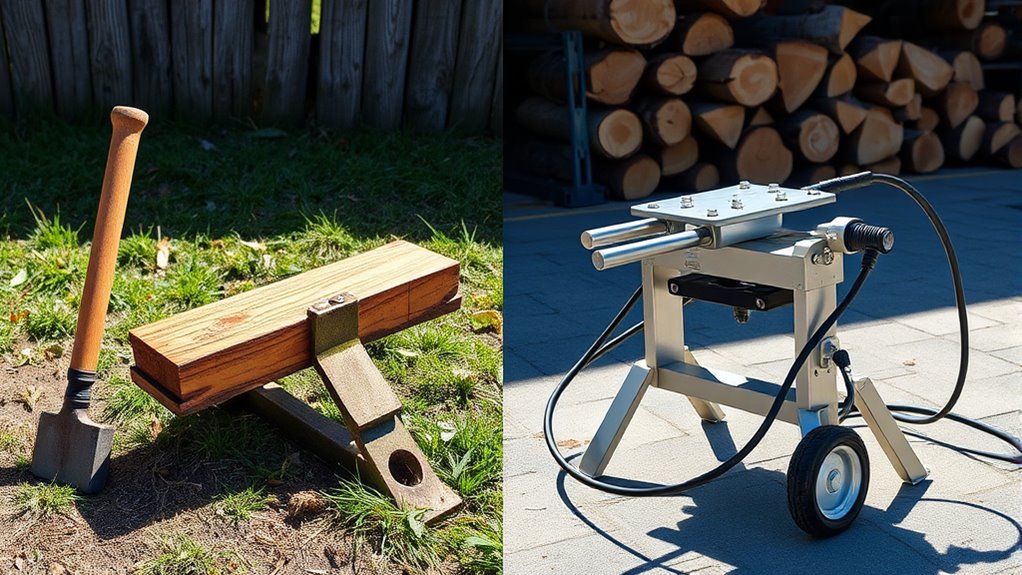
When it comes to cost and portability, manual log splitters typically come out ahead for budget-conscious users because they are generally less expensive upfront and require no electricity or fuel. They’re lightweight, easy to transport, and don’t need a power source, making them ideal for small or remote jobs. Hydraulic splitters, on the other hand, tend to be more costly initially and can be bulky to move.
Consider these points:
- Manual splitters are cheaper to buy and maintain.
- They are lightweight and portable.
- Hydraulic splitters often need a power source, adding to costs.
- Hydraulic models are heavier and less easy to move around.
If budget and portability are your priorities, manual options are the clear choice.
Efficiency and Speed Considerations
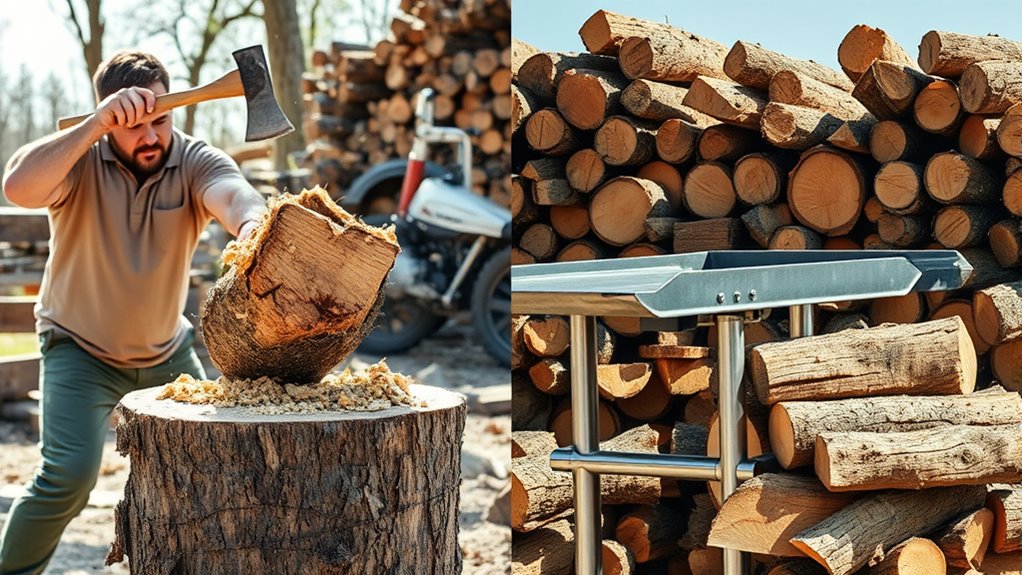
Are manual and hydraulic log splitters equally efficient when it comes to speed? Not quite. Hydraulic splitters generally work faster because they use pressurized fluid to generate significant force quickly, allowing you to split logs in seconds. You can process larger quantities of wood in less time with a hydraulic model, especially for seasoned or tough logs. Manual splitters, on the other hand, rely on your strength and effort, making the process slower. If you need to split many logs or have tight deadlines, hydraulic splitters save you time and effort. However, for small jobs or occasional use, manual options might still be sufficient. Ultimately, your choice depends on how quickly you want to complete your work and the volume of logs you handle regularly.
Physical Demands and Safety
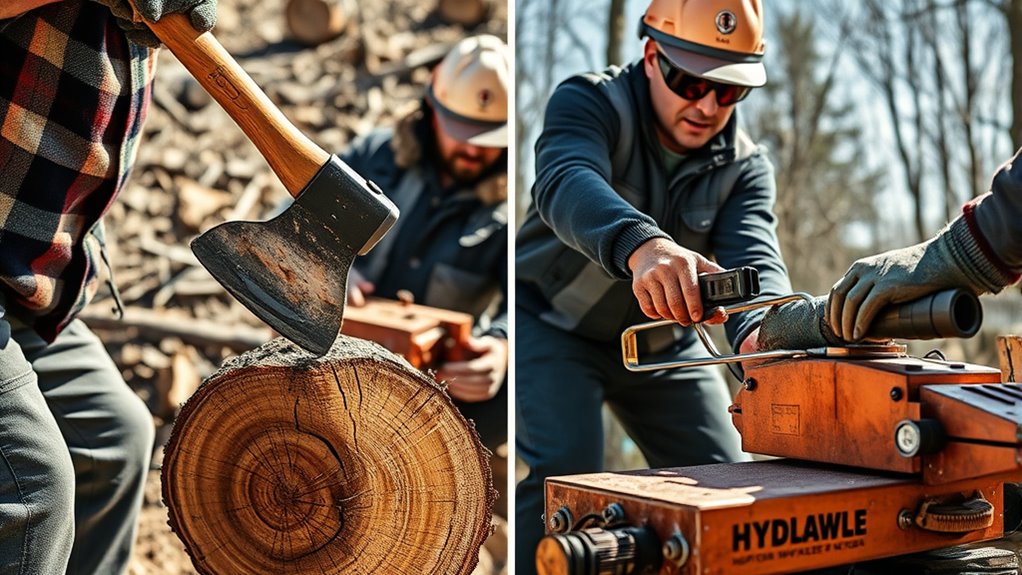
You’ll need to contemplate how much physical strength each method demands and how that affects your safety. Manual splitting often requires more effort and carries a higher risk of injuries from missed strikes or improper technique. Hydraulic systems, while easier on your body, still require careful attention to safety protocols to prevent accidents.
Physical Strength Requirements
Manual log splitting demands significant physical strength, requiring you to exert considerable force to drive wedges or swing axes effectively. You need core endurance and upper body power to split logs efficiently and safely. Without enough strength, you risk improper technique or injury. To handle this task, you should be prepared to:
- Use strong grip and firm stance to control tools
- Generate enough force with your arms and shoulders
- Maintain stamina for repetitive swings or pushes
- Be aware of your body’s limits to avoid overexertion
These demands mean that manual splitting isn’t suitable for everyone, especially those with limited strength or physical issues. Proper technique and strength are essential for safe, effective splitting, reducing fatigue and injury risks.
Risk of Injury
Because manual log splitting requires significant physical effort, it also carries a notable risk of injury if proper safety precautions aren’t followed. You might strain muscles, sprain joints, or even suffer cuts from sharp tools if you’re not careful. The repetitive motion and force needed increase the chance of overexertion, leading to fatigue that impairs judgment and technique. Improper stance or technique can cause slips, falls, or missed strikes, risking broken bones or bruises. Additionally, logs can unexpectedly shift or kick back, hitting you and causing injury. Wearing appropriate protective gear—like gloves, eye protection, and sturdy footwear—helps reduce these risks. Staying alert, using correct techniques, and maintaining focus are essential to prevent accidents and keep yourself safe during manual log splitting.
Equipment Safety Protocols
Ensuring equipment safety during log splitting is crucial to minimizing physical strain and preventing accidents. Always inspect your tools before use; look for cracks, rust, or damage. Follow proper operating procedures to avoid mishandling or misuse. Keep your workspace clear of obstructions to prevent trips and falls. Use personal protective gear like gloves, eye protection, and sturdy boots.
Remember these safety protocols:
- Wear appropriate protective equipment at all times
- Regularly maintain and check your equipment for faults
- Keep hands and feet clear of moving parts
- Turn off and unplug tools before inspecting or adjusting
Environmental Impact and Energy Use

Hydraulic log splitters typically consume more energy and have a larger environmental footprint than manual methods. They rely on electricity or fuel, which can contribute to pollution and greenhouse gas emissions. In contrast, manual splitting uses human effort, producing no emissions and minimal waste. To illustrate, consider this comparison:
| Method | Energy Source | Environmental Impact | Efficiency |
|---|---|---|---|
| Manual | Human effort | Low, zero emissions | Slower |
| Hydraulic | Electricity/Fuel | Higher emissions, fossil fuel use | Faster |
| Both | – | – | Varies |
| Environmental | Minimal | Minimal impact | Variable |
Your choice affects not only convenience but also your environmental footprint.
Choosing the Right Method for Your Needs
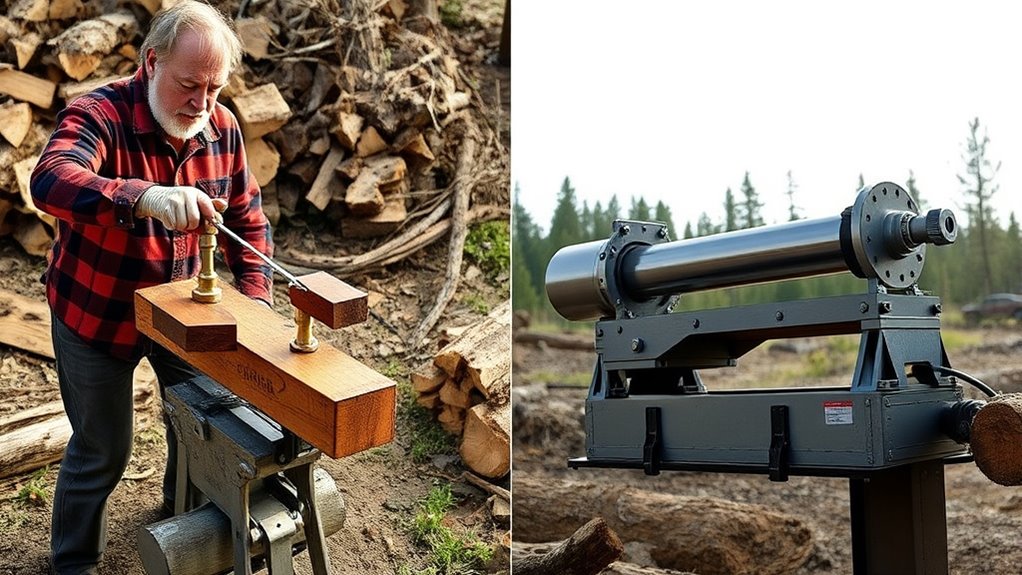
Choosing the right log splitting method depends on your specific needs, priorities, and available resources. Consider how often you’ll split wood, your strength, and your budget. Manual splitting works well if you have smaller quantities or want exercise, but it’s labor-intensive. Hydraulic splitters speed up the process and handle larger loads with less effort, though they come with higher upfront costs. Think about storage space; manual tools are portable, while hydraulic machines need a dedicated area. Safety is key—manual tools require skill, while hydraulic splitters have safety features but still demand caution. Finally, evaluate your environmental impact preferences, as manual methods often use no energy, whereas hydraulic options rely on electricity or fuel. Choose what best fits your workload, safety comfort, and environmental values.
Frequently Asked Questions
What Are the Best Safety Gear Recommendations for Manual Log Splitting?
When you’re manual log splitting, safety gear is essential. Wear sturdy gloves to protect your hands from splinters and cuts. Use safety glasses to shield your eyes from flying debris, and steel-toed boots to guard your feet. Consider ear protection if you’re working in a noisy environment, and always wear long pants and sleeves to prevent scratches and minor injuries. Staying protected guarantees you work safely and efficiently.
How Long Does It Typically Take to Split a Cord of Wood Manually?
Splitting a cord of wood manually usually takes between 4 to 8 hours, depending on your experience, tools, and the type of wood. You might spend more time with harder woods or if you’re working alone. To speed up the process, use sharp tools and proper techniques. Take breaks to stay safe and avoid fatigue, which can slow you down or cause injuries.
Are There Specific Wood Types Better Suited for Hydraulic Versus Manual Splitting?
You ask if certain wood types are better suited for hydraulic or manual splitting. Generally, dense hardwoods like oak or hickory are tougher and may require the power of hydraulic splitters for efficiency. Softer woods like pine or cedar split more easily by hand. Your choice depends on the wood’s hardness, size, and your strength, but hydraulic tools handle the toughest woods with less effort.
What Maintenance Is Required for Hydraulic Log Splitters Over Time?
You need to regularly check your hydraulic log splitter to guarantee it runs smoothly over time. Keep an eye on hydraulic fluid levels and top them off as needed, and change the fluid according to the manufacturer’s schedule. Inspect hoses and fittings for leaks or damage, and replace worn parts promptly. Also, clean the machine to prevent dirt buildup and lubricate moving parts to extend its lifespan.
Can Manual Log Splitters Handle Large, Tough Logs Effectively?
Imagine tackling a mountain of tough logs with confidence. Manual log splitters can handle large, stubborn logs, but it takes patience and effort. While they may not match hydraulic power, with proper technique and strength, you can split even the toughest wood. Just be prepared for a workout, and remember, the satisfaction of conquering those stubborn pieces makes the effort worthwhile.
Conclusion
Whether you prefer the classic charm of manual log splitting or the modern convenience of hydraulic tools, your choice depends on your needs and circumstances. Think of it like choosing between a trusty sword and a futuristic laser—each has its own advantages. Consider your budget, physical ability, and environmental impact. Whichever method you pick, just remember, in the end, it’s all about getting that wood split safely and efficiently for your cozy fireside nights.
